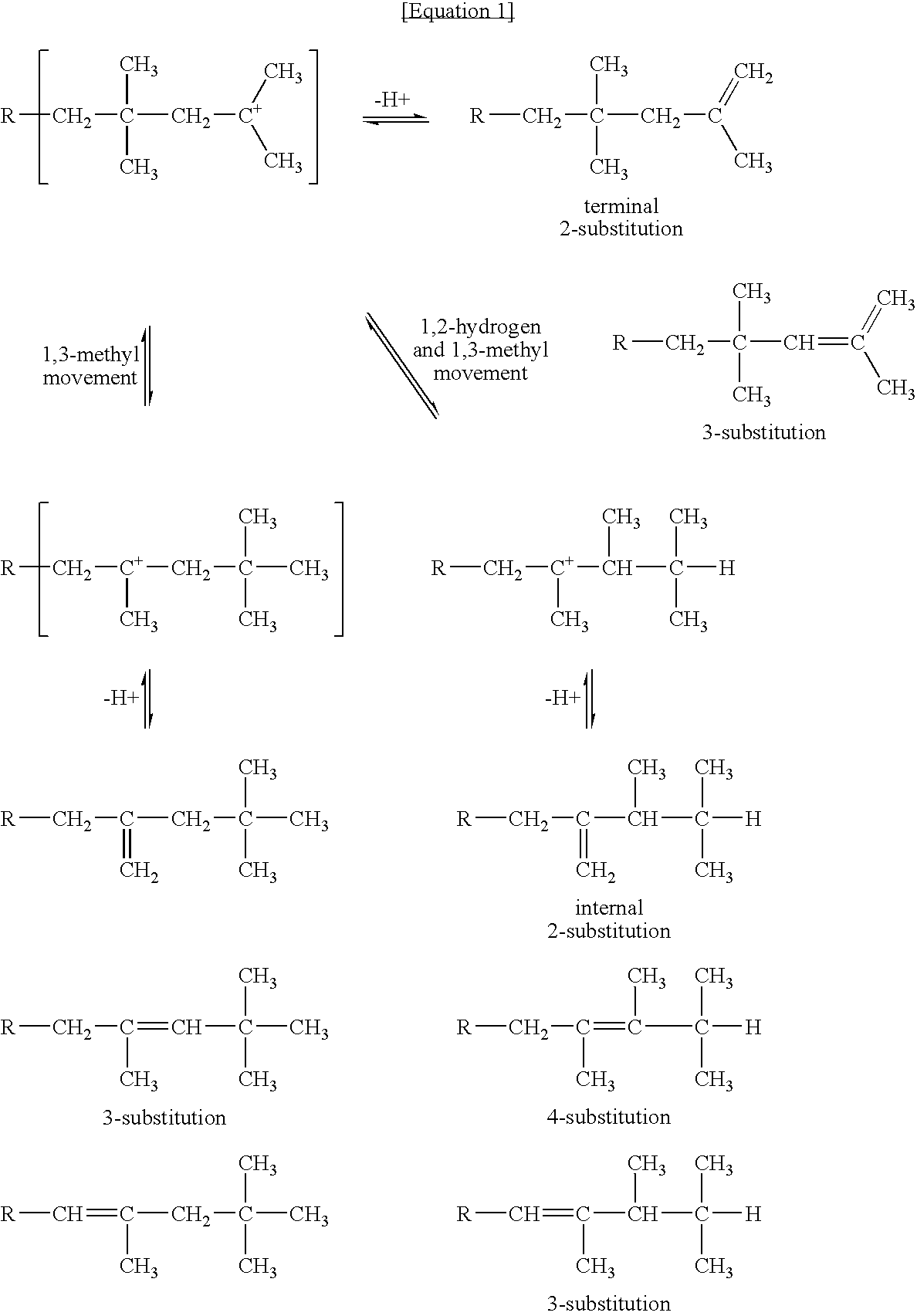Method for producing polybutene
a polybutene and polybutene technology, applied in the field of polybutene production, can solve the problems of reducing the reactivity of polybutene, increasing the demand for high reactive polybutene, and reducing the yield of pibsa
- Summary
- Abstract
- Description
- Claims
- Application Information
AI Technical Summary
Benefits of technology
Problems solved by technology
Method used
Image
Examples
example 1
[0029]3.63 g(54 mmol) of gaseous boron trifluoride was introduced into 100 ml reactor in which 7.65 g(75 mmol) of diisopropylether (IPE) was contained while cooling the reactor to −5° C. and stirring the reactor. 5.4 g(72.9 mmol) of t-butylalcohol was added to the produced white crystal, and stirred for 5 minutes to completely dissolve the white crystal. By passing nitrogen gas through the reactor for 5 minutes, the final catalyst was obtained. The obtained catalyst system and the raw material (C4 raffinate-1) having the composition shown in Table 1 were continuously introduced into a pressure reactor, which was maintained to −6° C. by a cooler. The pressure of the reactor was maintained to more than 3 kg / cm2 so that the raw material was in a liquid state. Average contact time was maintained to 45 minutes, and the catalyst system was introduced so that 0.2 weight part of BF3 was introduced per 100 weight part of isobutene in the raw material.
[0030]
TABLE 1Cis-Trans-Com-1-2-2-ponentIs...
example 2
[0032]17.68 g(261 mmol) of gaseous boron trifluoride was introduced into 100 ml reactor in which 19.13 g(188 mmol) of diisopropylether and 13.12 g(177 mmol) of t-butylalcohol were contained while cooling the reactor to −5° C. and stirring the reactants to obtain the catalyst. Except of using the produced catalyst system and that the polymerization temperature and the contact time were controlled as shown in Table 2, polybutene was produced in the same manner of Example 1. The catalyst system was used after removing free BF3 by passing nitrogen gas through the catalyst system for 5 minutes except the one marked “Free BF3 not removed” in Table 2.
[0033]
TABLE 2ReactionContactConversionMolecularTerminaltemperaturetimeratioweight MnVinylidene(° C.)(minute)(%)(polydispersity)Content (%)−44599 180 (1.30)82(Free BF3 notremoved)−44598 830 (1.36)83−64595 920 (1.45)85−815821400 (1.80)87−945871420 (1.90)89−12 45751750 (2.05)92−12 90901680 (1.95)90
example 3
[0034]The catalyst system of Example 2 was used after removing the free BF3, and the raw material including 65 weight % of isobutene and 35 weight % of isobutane was used. The polymerization was carried out at −12° C. of the reaction temperature and for 45 minutes of the contact time. After-treatment was performed for the produced polybutene in the same manner of Example 1. The properties of produced polybutene were analyzed. As a result, the molecular weight (Mn) of the produced polybutene was 1850, the polydispersity (Pd) was 1.85, the content of terminal vinylidene was 93%, and the conversion ratio of isobutene was 82%.
PUM
| Property | Measurement | Unit |
|---|---|---|
| mole ratio | aaaaa | aaaaa |
| temperature | aaaaa | aaaaa |
| temperature | aaaaa | aaaaa |
Abstract
Description
Claims
Application Information
 Login to View More
Login to View More - R&D
- Intellectual Property
- Life Sciences
- Materials
- Tech Scout
- Unparalleled Data Quality
- Higher Quality Content
- 60% Fewer Hallucinations
Browse by: Latest US Patents, China's latest patents, Technical Efficacy Thesaurus, Application Domain, Technology Topic, Popular Technical Reports.
© 2025 PatSnap. All rights reserved.Legal|Privacy policy|Modern Slavery Act Transparency Statement|Sitemap|About US| Contact US: help@patsnap.com

